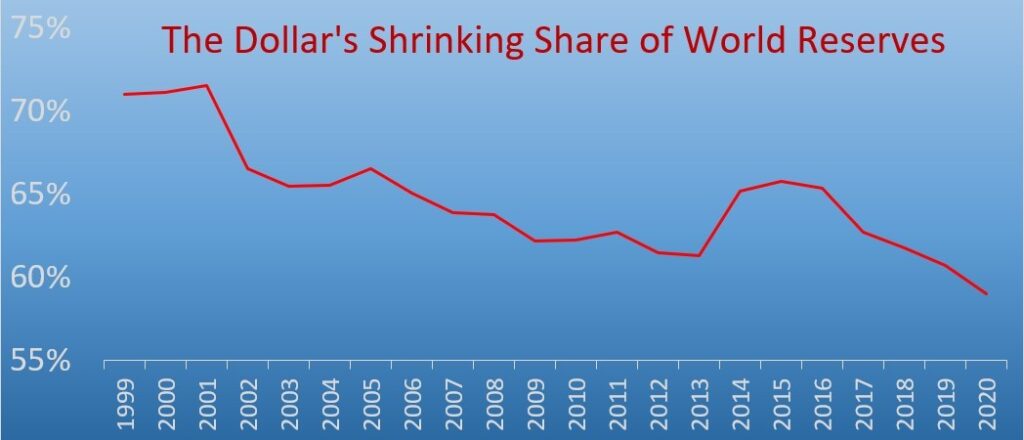I gotta be honest: I didn’t know that the wolf dies.
I’ve known the story my whole life: a few pigs; a couple of poorly constructed houses; a wolf—big and bad; some huffing and puffing.
But I did not recall that, in the end, the wolf climbs down the chimney of the brick house and lands in a pot of boiling water…and that the pigs eat him for dinner.
Dark. Very dark.
In any event, The Three Little Pigs popped into my head as I was researching some data on gold.
Stick with me—there is a connection.
In the last five years, the roughly 110 central banks for which the World Gold Council has data have together increased their gold holdings by just under 7%. Clearly, not a huge amount. But I figured there must be more going on here, so I did a bit of digging.
The more interesting story is that of the 53 central banks that upped their gold reserves over those five years, 47 are emerging markets/developing nations. Moreover, the cumulative increase in gold reserves for those 47 central banks was 15%, definitely a meaningful amount and more than double the world average.
Some countries (the UAE, Mongolia, Turkey, Hungary) bumped up their gold reserves by between 500% and more than 900%.
Now, we’re cooking with gas!
I started to ruminate on that. Why would such a large collection of emerging-market economies move so demonstrably into gold, as though doing so in unison?
Yes, there is the ever-worrisome concern about another global financial crisis. That’s a good reason. And, yes, emerging-market economies use gold to stabilize their currencies—another time-tested reason. But I don’t think that’s the full story since it doesn’t explain why emerging-market central banks doubled the global pace of gold buying.
I think something else is at play that has emerging-market countries on edge.
And I think that “something else” is good old-fashioned schoolyard bullying.
The U.S. has always treated the rest of the world like a big brother treats a little brother. He’s there to offer a bit of protection on occasion, but largely his self-defined role is to pick on you. Impose his own rule. Change those rules on a whim. Disregard them when convenient. And pretty much make you bend to his wants, regardless of your needs.
Over the last five years, the hazing has worsened. The number of economic threats were off the charts. The imposition of tariffs and anti-free-trade policies ratcheted markedly higher. Doesn’t matter if it was Europe or Mexico or Canada, the world saw the U.S. acting like a schoolyard bully, economically.
America had effectively weaponized the dollar—using the greenback as a bludgeon. That’s especially tough on emerging markets. They rely on the U.S. consumer and global trade to drive their local economies.
So, they’re reacting to protect their self-interests. And what do all of us learn to do when a bully is terrorizing the playground?
We go out of our way to avoid the bully.
That’s what’s going on here—plainly visible in the chart I included in a column some days ago showing that the dollar’s share of global financial reserves has sunk to 59%, the lowest level in a quarter century.

Gold’s share of global reserves, meanwhile, has risen.
In simple terms, much of the world is reducing its exposure to the dollar and snapping up gold as the replacement reserve. The little pigs are tired of the huffing and puffing, so they’re slowly limiting the wolf’s ability to blow (I told you there was connection).
Instead of holding greenbacks, they’re increasingly holding gold since the wolf isn’t strong enough to blow down a house made of gold.
This has big knock-on effects for me and you.
The reduction in dollar reserves—paired with the increase in gold reserves—directly leads to a weakening dollar and a strengthening gold price.
That means our costs of living rise since we import so much from around the world. It means our savings and our paychecks don’t go as far they once did. It means the value of our dollars and our dollar-based assets are eroding with the passage of time.
This isn’t an overnight phenomenon, of course. You’re not going to wake up tomorrow (probably) and find out a dollar collapse has destroyed 30% of your wealth (though that absolutely is a risk).
No, such trends tend to play out over time. The dollar is down 25% this century so far, relative to a basket of major world currencies. Likewise, gold is up 350% in that same period. This isn’t over.
My expectation—I laid this out in the March issue of the Global Intelligence Letter—is that the dollar will continue to fall until the latter half of this decade.
Conversely, we flip that around and see that we have a steep and persistent rise ahead in gold.
Gold so far this year is off by a negligible 3%. At $1,835 per ounce, it’s a decent buy. We will see $2,000 gold again this year. Possibly $2,500. And I’m confident $5,000 gold is in our future as the little pigs continue to isolate the wolf over the remainder of this decade.
So, as I routinely counsel—buy gold here and there when you have a bit of spare cash, and always during moments of temporary gold-price weakness. Don’t buy it for investment gains. Buy it because it’s going to preserve your spending power over time.
Buy it because the little pigs are telling you this is to protect yourself from what they’re already doing to the wolf.
Not signed up to Jeff’s Field Notes?
Sign up for FREE by entering your email in the box below and you’ll get his latest insights and analysis delivered direct to your inbox every day (you can unsubscribe at any time). Plus, when you sign up now, you’ll receive a FREE report and bonus video on how to get a second passport. Simply enter your email below to get started.
